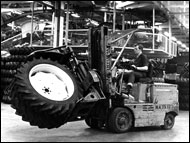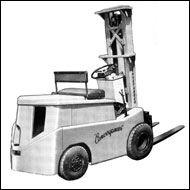 Two more companies who were worthy of a mention at the 1960 Earls Court Exhibition were Coventry Climax and Hyster. On their stand Coventry Climax displayed the new models IGEV and MSE from the Universal Major range. Both of these were four-wheeled machines and battery powered with lifting capacities of 5,000lbs and 6,000lbs to 130 inches respectively.
Two more companies who were worthy of a mention at the 1960 Earls Court Exhibition were Coventry Climax and Hyster. On their stand Coventry Climax displayed the new models IGEV and MSE from the Universal Major range. Both of these were four-wheeled machines and battery powered with lifting capacities of 5,000lbs and 6,000lbs to 130 inches respectively.
Although well represented, the new models on display from the American companies were very thin on the ground and relied to some extent on the Hyster Space Saver 40 forklift truck. Originally released by the company in the USA during 1959, this machine was being given its first British appearance at the Show. The model had a lifting capacity of 4,000lbs at 24-inch load centres and was powered by a 3-cylinder Perkins P3-144 diesel engine. Soon to be introduced on the British produced Hyster trucks, this machine displayed the new Monotrol foot control.
Mechanical Handling of People
As a digression, writes our author James Brindley, 27th September 1960 was a memorable day for some of the many workers in London who used the London underground system. For some years the congestion experienced by people using the stretch of line between Bank and Waterloo Station during the rush hour had been getting worse by the day. The bottleneck at the Bank end was due to the long, narrow pedestrian subway connecting the station platform with the road level, with no lift or escalator between them. On the date mentioned, conditions were completely changed by the opening of the `Trav-o-lator`, claimed to be the world’s largest, and Europe’s first, moving pavement. The system was designed to handle 20,000 people per hour on its 297 feet length, and rose 42 feet travelling at 180 ft/min.
The idea of moving pedestrians about by conveyor was by no means new, as was borne out by a report from a correspondent to a London newspaper. The person in question remembered using such a system at the Crystal Palace Exhibition some 60 years before. This was also a continuous flat belt, and was used to transport people from ground level to the galleries.
 Returning to forklifts, in October 1960 Conveyancer released details of their new style TC 6-24 forklift truck. This was slightly different to the TC 4-24 series 3 low cost versions released at the Earls Court exhibition, in that the transmission was torque converter and introduced the Perkins four 192Z diesel engines. Produced in four lift capacities of 4,000lbs, 5,000lbs, 6000lbs and 7,000lbs at 24-inch load centres, the machines were available with cushion or pneumatic tyres. As with the low cost versions, a gas option was also available.
Returning to forklifts, in October 1960 Conveyancer released details of their new style TC 6-24 forklift truck. This was slightly different to the TC 4-24 series 3 low cost versions released at the Earls Court exhibition, in that the transmission was torque converter and introduced the Perkins four 192Z diesel engines. Produced in four lift capacities of 4,000lbs, 5,000lbs, 6000lbs and 7,000lbs at 24-inch load centres, the machines were available with cushion or pneumatic tyres. As with the low cost versions, a gas option was also available.
In Germany, Jungheinrich launched the Ant Junior, the first of its compact forklift trucks onto the market. It would become known as the Volkswagen of the fork truck industry. Other German companies who launched new equipment at this time were Sichelsmidt with their battery powered stacker, model Dixie Mucke 4, and Steinbock with the Eurolift/Triolift, a larger capacity version of the now well-established `Piccolift`.
Further north in Sweden, Atlet launched the Standstacker, a stand on support arm stacker with patented side stabilisers. These kept the machine balanced and gave the machine the facility of lifting to a height that could compete, to some extent, with the reach trucks of the day.
By James Brindley, Director, National Fork Truck Heritage Centre
To be continued




1 Comment
Hi,
Any info on aConvayencer TC620?
Regards,
Herman